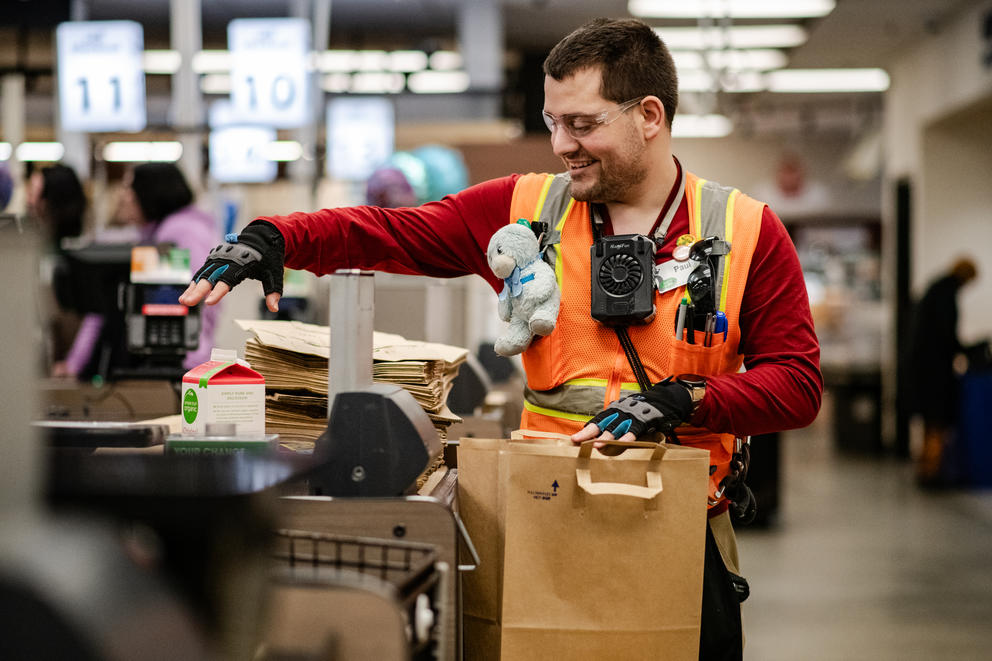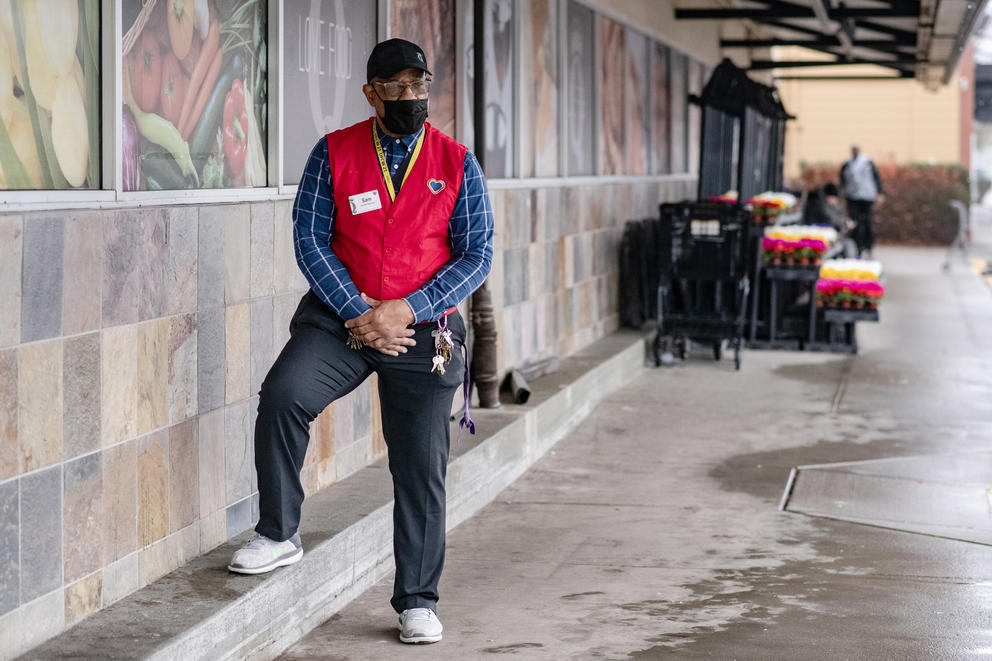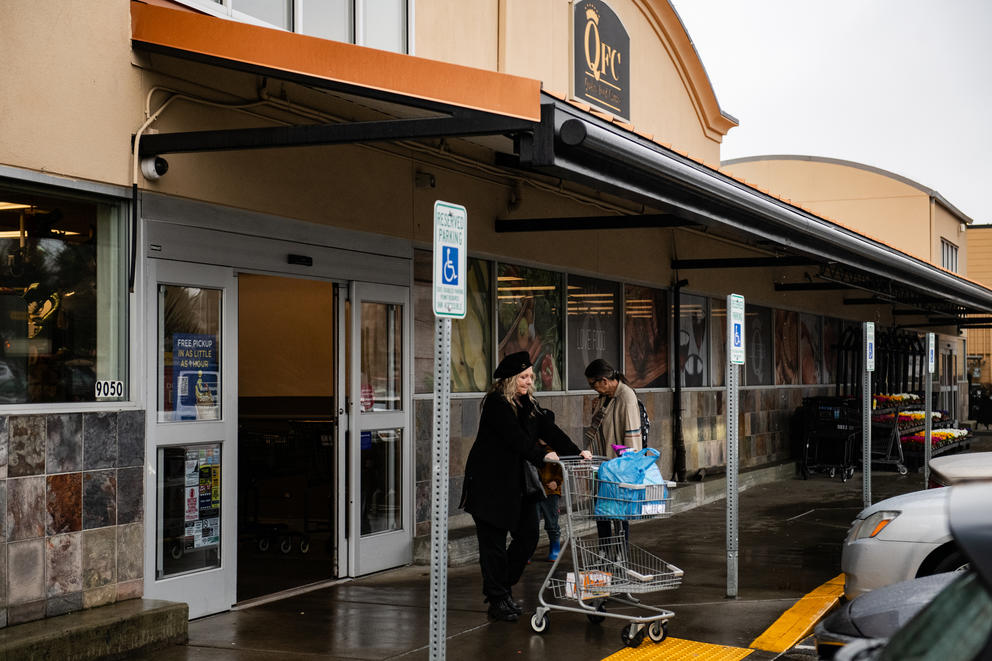“It keeps me from having to push with my body, putting pressure on my spine,” Smith explained. “I use my arms and my upper body to do all the work without having to put extra strain on my back, and that lets me do a lot more.”
Kroger, the supermarket giant that owns QFC and Fred Meyer, hopes to consummate a $24.6-billion merger with Albertsons, the owner of Safeway, in the coming weeks in a move that would mark the largest consolidation in supermarket industry history.
Smith fears the proposed megamerger could cause him to lose some of the benefits he has gained in the five years he has been at the store.
“I’m concerned about my medical benefits,” Smith said. “I’m concerned about my seniority. I’m concerned about my job stability, because I’m disabled. … With this going through, that might screw me over.”
As part of an antitrust deal to win over the Federal Trade Commission, the companies announced a plan to sell more than 400 stores nationwide, including 104 in Washington, to C&S Wholesale Grocers, a New Hampshire-based grocer that runs Piggly Wiggly and Grand Union supermarkets.
Kroger and Albertsons have not disclosed which stores they plan to sell in the $1.9-billion deal, but significant market overlap in Washington means more stores are being offered up in this state than any other. Kroger has also published a commitment that “no stores will close as a result of the merger,” “frontline associates will remain employed” and “collective bargaining agreements will be honored.”
But workers, union representatives and dozens of supporter organizations aren’t convinced.
“A lot of [QFC workers] are just living from paycheck to paycheck, all their lives,” said Samuel Dancy, a front-end manager who has worked at a QFC in West Seattle for 32 years. “We as people, we’re told, ’Work hard and you can live the American Dream and you can get a slice of pie.’ Well, Kroger doesn’t want us to have a slice of pie. They want us to just have crumbs. And I’m sorry, you can’t get fed off of crumbs.”
The United Food and Commercial Workers represents workers at both Kroger and Albertsons stores. John Marshall, the capital strategies director at UFCW 3000, the Washington, northern Idaho and northeast Oregon branch of the union, said grocery workers often rely on meaningful competition to win wage and workplace concessions.
“Currently, when we are seeking bargain for improvements in health care benefits, in retirement plans, in wages, in safety, in a whole other host of issues, we are able to play [Kroger and Albertsons] off against each other,” Marshall said. “Once they are allowed to merge, that power for the workers goes away.”
This story is part of Crosscut’s WA Workplace Watch, an investigative project covering worker safety and labor in Washington state.
Opponents have also warned that any resulting store closures could exacerbate food insecurity, creating food deserts where local communities have limited access to healthy, affordable food.
Media representatives for Kroger did not respond to requests for comment. A media representative for Albertsons said no one at the company would speak on-record with Crosscut.
The FTC has yet to take a stance on the proposed consolidation, but commission chair Lina Khan has participated in several listening sessions where workers have spoken against the merger, and federal officials recently released new guidelines on such mergers. A court ruling indicates that the FTC plans to announce its response before Jan. 17.
The proposed deal
Kroger is the largest supermarket chain in the U.S. Its subsidiaries include QFC, Fred Meyer, Metro Market, Pay Less, Ralphs, Dillons, Smith’s, King Soopers, Harris Teeter, Owen’s and others. It reported $148 billion in sales in 2022.
Albertsons, headquartered in Boise, remains the second largest nationwide. It’s Washington’s largest grocer, with 184 Safeway locations in the state.
Since announcing the proposed merger in October 2022, the chains have argued it is a necessary move to compete with national chains like Walmart and Costco, which act as both supermarkets and department stores, as well as Amazon’s emerging online model.
“In any merger, companies typically are trying to achieve efficiencies, cost savings,” said Douglas Ross, an antitrust expert at the University of Washington School of Law. “Typically, if you’ve got a merger between two companies in the same area, they are going to achieve some cost savings by reducing employment. And that is typical and ordinary. And although it might sound harsh, from an economic point of view it leads to progress, frankly. If we didn’t have more efficiencies, our economy wouldn’t grow and we wouldn’t have advances.”
The agreement to divest 413 stores to C&S Wholesale Grocers was likely included in anticipation of antitrust challenges by the FTC. UFCW 3000’s Marshall recalled the 2015 Safeway/Albertsons merger, which included a similar antitrust clause to sell 146 stores to Bellingham-based grocer Haggen. Haggen filed for bankruptcy protection six months later and sold off the real estate for most of the stores. Dozens of stores were sold back to Albertsons, while many others closed for good.
“The similarities between the Haggen divestiture and the proposed divestiture to C&S are very concerning to us,” Marshall said. “It appears that, as was the case with Haggen, C&S is being offered these stores, as well as eight distribution centers and some other assets, for a rock-bottom price that essentially is going to allow them to turn a profit on the transaction even if their stores fail.”
Ross noted that C&S Wholesale Grocers is much bigger and better equipped to take on new stores than Haggen, which operated just 18 stores before the 2015 merger.
“It’s a cautionary tale,” Ross said. “And the Federal Trade Commission is going to want to be sure that this company, C&S Grocers, is really going to run the stores they buy successfully.”
Almost all of the stores proposed for divestiture are located in the western half of the U.S. More are being offered in Washington than in any other state because of significant market overlap.
Smith’s QFC at Westwood Village, for example, sits just two blocks from a Safeway. One or the other will almost certainly be sold off if the merger goes through.
“That’s the sort of place where they will have to divest,” Ross said.
Workers voice their fears
Samuel Dancy has worked at the Westwood Village QFC since it opened in 1991. In his three decades on the job, he has worked on the night crew, as a receiving clerk, as a natural foods manager, as a dairy manager and now as a front-end manager. Dancy is also the shop steward for UFCW 3000. In 2022 he helped negotiate a three-year contract that includes a stronger health care plan, increased pension funding and pay increases of $4-$9 an hour for longtime employees – benefits that helped make up for the risk and higher workload workers took on during the pandemic.
“We’ve been facing reduced staffing levels in our store during and after COVID,” Dancy said. “Our experience is that this would only get worse if the merger was allowed. We need to increase staffing, improve our schedules and increase our leverage as unionized grocery store workers, not go the other way.”
Cliff Powers, who now works at the Safeway in Anacortes, experienced the 2015 Haggen failure personally. He worked at the Oak Harbor Safeway from 1988 to 2015 until he was transferred to Haggen after the Safeway/Albertsons merger. The store he was sent to closed less than a year later. A bankruptcy judge later ruled that Safeway had to rehire him and 11 of his co-workers.
Powers said he wants to see more weight behind Kroger and Albertsons’ commitment that workers won’t face repercussions from the merger. “Put some guarantees behind what you’re saying,” he said. “[For example,] ‘If you guys lose your job within X number of months, we’re gonna pay you.’”
Find tools and resources in Crosscut’s Check Your Work guide to search workplace safety records and complaints for businesses in your community.
Kim Young, who works at the same Anacortes Safeway and has worked in the grocery industry since 1995, said she fears the shakeup could undermine benefits and worker camaraderie. Some hard-won benefits, specifically her paid vacation time, were critical for her after her husband died in an accident in 2020. She said she is especially grateful for the sympathetic store director who took care of everything when it happened.
“I called to tell him I wasn’t coming — Well, I couldn’t hardly get it out,” Young said. “He was trying to figure out what was going on, and my mom took the phone and told him what happened. He says, ‘Oh my God. You tell her to take whatever time she needs. We’ll figure out something.’”
What can the FTC actually do?
Throughout Khan’s two-year tenure, the FTC has overseen almost 40 merger challenges, and started lawsuits or sought injunctions against some of the largest companies in the U.S., including Amazon, Microsoft and Meta.
“For several decades, there had been the view that it was better to err on the side of being hands-off,” Khan said at The New York Times DealBook Summit in November, “the view being that even if you were to have monopoly power, that monopoly power would be dissipated by entry by market forces, whereas it would be difficult to undo or fix the harms of an erroneous government decision. I think we’re at a stage where we realize that that bias in favor of inaction has had enormous costs across our economy. And so that’s why you’re seeing this rebalance that’s going on right now.”
In practice, the agency, which has about 1,200 employees, has seen mixed results. It has lost every merger challenge that has made it through the courts during Khan’s tenure. Still, a major part of the FTC’s strategy is deterrence. In that same time, at least 19 merger deals were tossed by companies before reaching litigation.
The FTC and the Department of Justice (DOJ) released their newest merger guidelines in December. The document includes new language against mergers that may restrict competition in the labor market.
“[Current FTC leaders] view consolidation in structural terms,” said Marshall Steinbaum, an assistant professor of economics at the University of Utah. “That word has a negative association among most economists, but not with me. And it’s [the FTC’s] job to basically resist and push back on that in the interest of a broad set of stakeholders. The operative question here is whether they see this particular transaction, and enforcement against this transaction, as the forum in which to fight that larger battle.”
Steinbaum published the paper “Evaluating the Competitive Effect of the Proposed Kroger-Albertsons Merger in Labor Markets,” in which he tried to show that the consolidation would harm competition — reducing wages, working hours and union leverage.
“Workers would have less bargaining power on the job, because the merger would eliminate outside employment options,” Steinbaum said. “The labor markets are already fairly concentrated, and getting more concentrated, so large employers account for a high share of employment. And the more concentrated they are, the fewer alternative employers.”
Ultimately, Steinbaum said he thinks that if the FTC decides to challenge the merger, it would not do so solely on labor-market grounds. He expects the legal challenge would emphasize the ways the merger would affect consumers, but he is hopeful it would contain a labor-market aspect too.
UW antitrust expert Ross said he does not think a challenge focused on the negative effects for the labor market would be winnable.
“The workers’ leverage is, ’We could go to another supermarket, or we could find other jobs,’” Ross said. “It is going to be hard for an antitrust enforcer to say that there is an antitrust problem in the labor market as a result of this merger.”
Steinbaum and Ross both pointed to the 2022 DOJ injunction against book publisher Penguin Random House’s attempt to acquire Simon & Schuster as possible precedent for a labor-market argument against the merger. A U.S. District Court judge ruled in favor of the DOJ, which argued that the merger would create a “monopsony,” a market in which there is only one buyer, for authors selling book manuscripts.
In a video trying to sell the merger, Albertsons CEO Vivek Sankaran announced that the merged companies would donate 10 billion meals by 2030, “enough to feed every person in the cities of Seattle, Denver, Chicago and Boston every meal every day for nearly two years. Neither company could achieve this kind of impact alone.”
Like the divestiture commitments to protect jobs and store locations, such a promise is not legally binding. QFC manager Dancy said he has a hard time trusting the company will follow through when there are no consequences for failing.
“When I started in 1991, they respected us, they protected us and they paid us,” he said. “I had to struggle, but I dealt with it. And I don’t think people have a problem with struggling, as long as they can see the light at the end of the tunnel.”
Get the latest investigative news
A newsletter for resources, data and behind-the-scenes insight into investigative efforts.









